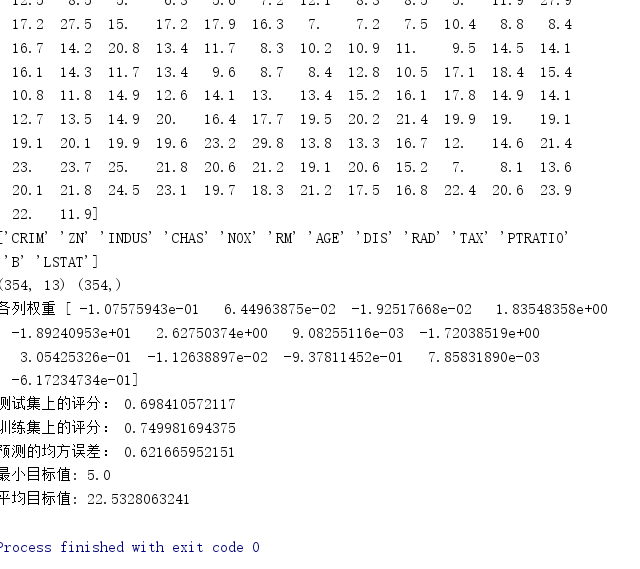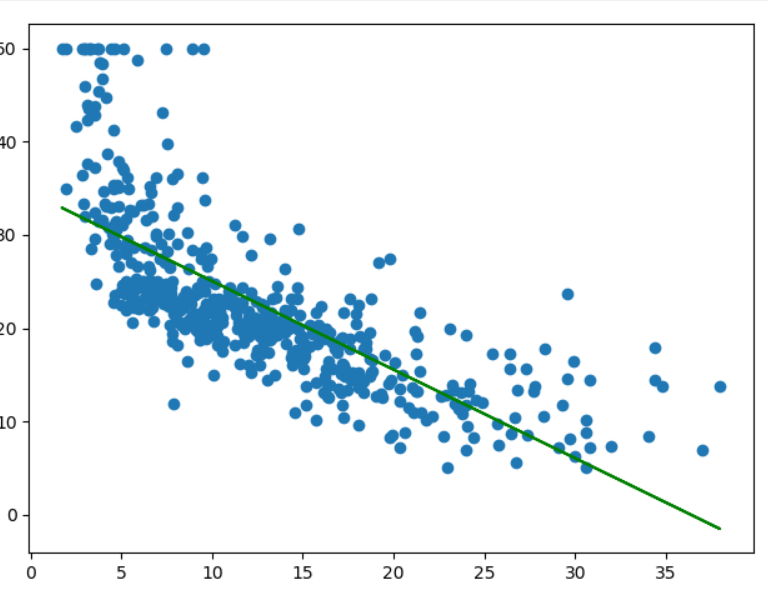期末大作业
1.波士顿房价预测
# 线性回归模型:建立13个变量与房价之间的预测模型,并检测模型好坏
import numpy as np
from sklearn.datasets import load_boston
from sklearn.linear_model import LinearRegression
from sklearn.model_selection import train_test_split
import matplotlib.pyplot as plt
# 读取数据集
boston = load_boston()
print(boston.keys())
print(boston.target) # 房价数据
print(boston.feature_names) # 数据集特征
# 划分训练集与测试集
# 随机擦痒25%的数据构建测试样本,剩余作为训练样本
X_train, X_test, y_train, y_test = train_test_split(boston.data, boston.target, test_size=0.3) # random_state:是随机数的种子
print(X_train.shape, y_train.shape)
# 建立模型
LineR = LinearRegression()
LineR.fit(X_train, y_train)
# 检查模型好坏
x_predict = LineR.predict(X_test)
print("各列权重", LineR.coef_)
print("测试集上的评分:", LineR.score(X_test, y_test))
print("训练集上的评分:", LineR.score(X_train, y_train))
print("预测的均方误差:", np.mean(x_predict - y_test) ** 2)
print("最小目标值:", np.min(boston.target))
print("平均目标值:", np.mean(boston.target))
# 画图
X = boston.data[:, 12].reshape(-1, 1)
y = boston.target
plt.scatter(X, y)
LineR2 = LinearRegression()
LineR2.fit(X, y)
y_predict = LineR2.predict(X)
plt.plot(X, y_predict, 'g')
plt.show()
# 多项式回归模型:建立13个变量与房价之间的预测模型,并检测模型好坏
from sklearn.datasets import load_boston
from sklearn.linear_model import LinearRegression
from sklearn.model_selection import train_test_split
from sklearn.preprocessing import PolynomialFeatures
import matplotlib.pyplot as plt
# 读取数据集
boston = load_boston()
# 划分训练集与测试集
# 随机擦痒25%的数据构建测试样本,剩余作为训练样本
x_train, x_test, y_train, y_test = train_test_split(boston.data, boston.target, test_size=0.3) # random_state:是随机数的种子
x = x_train[:, 12].reshape(-1, 1)
poly = PolynomialFeatures(degree=2)
x_poly = poly.fit_transform(x)
# 建立多项式回归模型
lrp = LinearRegression()
lrp.fit(x_poly, y_train)
lr = LinearRegression()
lr.fit(x, y_train)
w = lr.coef_
b = lr.intercept_
# 预测
x_poly2 = poly.transform(x_test[:, 12].reshape(-1, 1))
y_ploy_predict = lrp.predict(x_poly2)
# 画图
plt.scatter(x_test[:, 12], y_test)
plt.plot(x, w * x + b, 'y')
plt.scatter(x_test[:, 12], y_ploy_predict, c='r')
plt.show()



2.新闻文本分类
#导包 import jieba import os # 导入停用词 stopword=open('D:\stopsCN.txt','r',encoding="utf-8").read() #数据处理 def processing(tokens): # 去掉非字母汉字的字符 tokens = "".join([char for char in tokens if char.isalpha()]) # 结巴分词 tokens = [token for token in jieba.cut(tokens,cut_all=True) if len(token) >=2] # 去掉停用词 tokens = " ".join([token for token in tokens if token not in stopword]) return tokens #词频统计 def count(tokens): lifedict = {} for word in tokens: if len(word) == 1: continue else: lifedict[word] = lifedict.get(word, 0) + 1 wordlist = list(lifedict.items()) wordlist.sort(key=lambda x: x[1], reverse=True)#降序排序 #读取文件 all_txt=[] all_target=[] path = r'D:\0369' files = os.listdir(path) for root,dirs,files in os.walk(path): for file in files: filepath = os.path.join(root, file) # 文件路径 tokens=open(filepath,'r',encoding='utf-8').read() tokens=processing(tokens) all_txt.append(tokens) target = filepath.split('\\')[-2]#按文件夹获取特征名 all_target.append(target) #按6:4比例分为训练集和测试集 from sklearn.model_selection import train_test_split x_train,x_test,y_train,y_test=train_test_split(all_txt,all_target,test_size=0.4,stratify=all_target) #将其向量化 from sklearn.feature_extraction.text import TfidfVectorizer vectorizer=TfidfVectorizer() X_train=vectorizer.fit_transform(x_train) X_test=vectorizer.transform(x_test) #分类结果显示 from sklearn.naive_bayes import MultinomialNB mnb=MultinomialNB() clf=mnb.fit(X_train,y_train) #进行预测 y_predict = clf.predict(X_test) # 输出模型精确度 from sklearn.model_selection import cross_val_score from sklearn.metrics import classification_report scores=cross_val_score(mnb,X_test,y_test,cv=4) print("Accuracy:%.3f"%scores.mean()) # 输出模型评估报告 print("classification_report:\n",classification_report(y_predict,y_test)) y_nb_pred = clf.predict(X_test) # 将预测结果和实际结果进行对比 import collections import matplotlib.pyplot as plt from pylab import mpl mpl.rcParams['font.sans-serif'] = ['FangSong'] # 指定默认字体 mpl.rcParams['axes.unicode_minus'] = False # 解决保存图像是负号'-'显示为方块的问题 # 统计测试集和预测集的各类新闻个数 testCount = collections.Counter(y_test) predCount = collections.Counter(y_predict) print('实际:',testCount,'\n', '预测', predCount)

# 建立标签列表,实际结果列表,预测结果列表,
nameList = list(testCount.keys())
testList = list(testCount.values())
predictList = list(predCount.values())
x = list(range(len(nameList)))
print("新闻类别:",nameList,'\n',"实际:",testList,'\n',"预测:",predictList)



